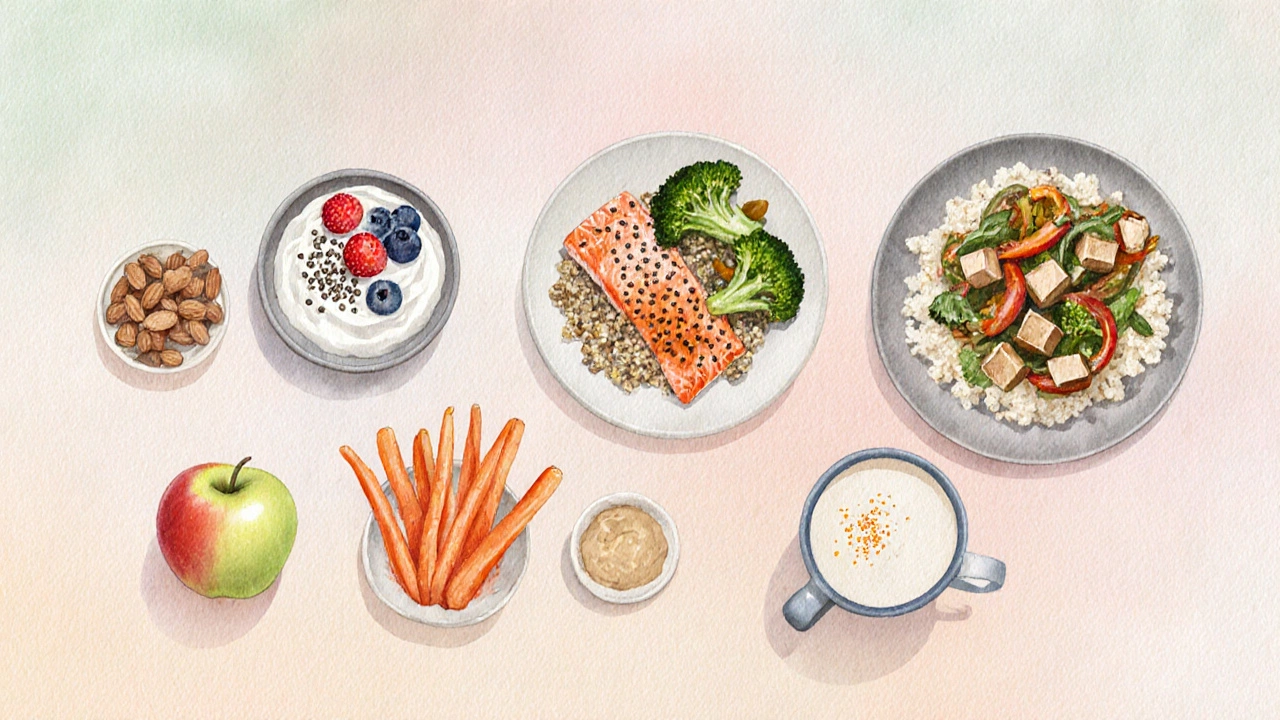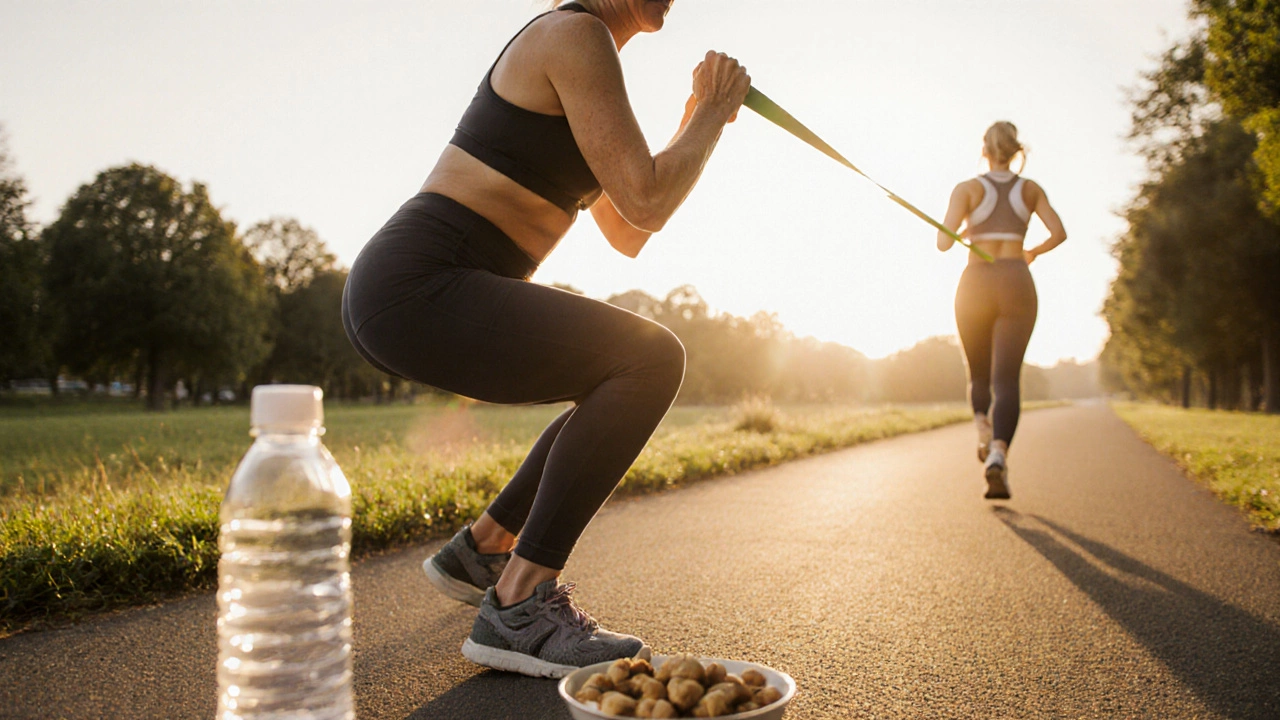Calorie & Macronutrient Calculator for Women Over 50
Personalized Nutrition Calculator
Get your customized calorie and macronutrient targets based on your individual needs.
When a 55‑year‑old woman asks, “What should I eat to lose weight?”, the answer isn’t a one‑size‑fits‑all fad. Hormonal changes, slower metabolism, and shifting activity levels all play a role. Below you’ll find a practical roadmap that blends science‑backed nutrition, easy‑to‑follow meals, and lifestyle tweaks that actually move the needle.
Weight loss diet for 55-year-old women is a nutrition strategy tailored to the unique metabolic and hormonal profile of women in their mid‑fifties. It focuses on modest calorie reduction, higher protein, plenty of fiber, and foods that support bone health and heart health while respecting the changes that come with menopause.
Key Takeaways
- Aim for 1,200‑1,500kcal per day, adjusted to activity level and medical conditions.
- Prioritize protein (≈1.0‑1.2g per kg body weight) to preserve muscle mass.
- Include at least 25g of fiber daily to aid digestion and control blood sugar.
- Choose healthy fats (omega‑3, monounsaturated) over saturated fats.
- Pair nutrition with regular strength training, 150min of moderate cardio, good sleep, and stress‑reduction techniques.
Understanding the Nutritional Landscape at 55
Three physiological shifts shape food choices:
- Menopause hormones - lower estrogen can increase abdominal fat and affect insulin sensitivity.
- Basal Metabolic Rate (BMR) slowdown - muscle loss and thyroid changes shave off up to 200kcal/day.
- Bone density concerns - calcium and vitaminD become critical to prevent osteoporosis.
Addressing these points means focusing on protein, calcium‑rich foods, and low‑glycemic carbs.
Calorie Target and Macronutrient Breakdown
Use a simple formula to estimate daily calories: Body weight (kg) × 22kcal for a sedentary lifestyle, then subtract 300‑500kcal for weight loss. For a 70‑kg woman, that’s roughly 1,540kcal; a modest cut lands at 1,200‑1,300kcal.
Macronutrient split that works well:
- Protein: 25‑30% (≈90‑100g) - supports muscle maintenance.
- Fat: 25‑30% - focus on monounsaturated (olive oil, avocado) and omega‑3 (fatty fish, flaxseed).
- Carbohydrates: 40‑50% - choose high‑fiber, low‑glycemic options.
Sample One‑Day Meal Plan (≈1,350kcal)
| Meal | Food Items | Portion / Calories |
|---|---|---|
| Breakfast | Greek yogurt with mixed berries and 1tbsp chia seeds | 200g / 250kcal |
| Mid‑morning Snack | 1 small apple + 10almonds | 150kcal |
| Lunch | Grilled salmon (100g), quinoa (½ cup cooked), roasted broccoli, drizzle of olive oil | 350kcal |
| Afternoon Snack | Carrot sticks with 2tbsp hummus | 120kcal |
| Dinner | Stir‑fried tofu (150g) with mixed bell peppers, snap peas, ginger‑garlic sauce, served over cauliflower rice | 350kcal |
| Evening Snack (optional) | Warm milk (250ml) with ½tsp turmeric | 80kcal |
This plan hits ~30g of protein at each main meal, provides >25g fiber, and stays within the calorie window.

Choosing the Right Diet Pattern
Three well‑researched patterns align with the goals of a 55‑year‑old woman. Use the table below to decide which feels easiest to sustain.
| Diet | Calorie Density | Protein % | Key Benefits for Menopause |
|---|---|---|---|
| Mediterranean | Low‑moderate | 25% | Rich in omega‑3, supports heart health, reduces hot‑flash frequency. |
| DASH (Dietary Approaches to Stop Hypertension) | Low | 20% | Emphasizes potassium & magnesium, helps blood pressure and bone density. |
| Low‑Carb (≤30% carbs) | Low | 30‑35% | Improves insulin sensitivity, may reduce abdominal fat. |
All three can be adapted to the calorie target; the best choice is the one you’ll enjoy daily.
Practical Tips to Stay on Track
- Portion control: Use your hand as a guide - palm for protein, fist for veggies, cupped hand for carbs.
- Meal prep: Cook a batch of quinoa or brown rice on Sunday, portion‑size veggies, and store protein in zip‑lock bags.
- Hydration: Aim for 2‑2.5L water daily; sometimes thirst mimics hunger.
- Mindful eating: Put away devices, chew each bite 20‑30 times.
- Strength training: Two 30‑minute sessions per week (bodyweight squats, resistance bands) preserve lean mass.
- Cardio: Brisk walking, cycling, or swimming for at least 150minutes each week.
- Sleep hygiene: 7‑8hours, dark room, limit caffeine after 2pm.
- Stress management: 10‑minute deep‑breathing, yoga, or a hobby you love.
Common Pitfalls and How to Avoid Them
Even with a solid plan, missteps happen. Spot the warning signs early:
| Pitfall | Why It Happens | Counter‑Strategy |
|---|---|---|
| Skipping meals | Leads to binge‑eating later. | Set three main meals + two small snacks; keep fruit or nuts handy. |
| Relying on diet pills | Short‑term fixes don’t address hormonal changes. | Focus on whole foods; discuss any supplements with a doctor. |
| Ignoring portion sizes | Calorie estimate collapses. | Use a kitchen scale for the first two weeks to train eye. |
| Not adjusting for activity level | Too few calories can cause fatigue. | Re‑calculate BMR after any major lifestyle change. |
| Neglecting calcium & vitaminD | Bone loss accelerates post‑menopause. | Include dairy, fortified plant milks, or a supplement after labs. |

When to Seek Professional Guidance
Because every woman’s health story is different, consider these red flags:
- History of heart disease, diabetes, or thyroid disorders.
- Sudden, unexplained weight loss or gain.
- Joint pain limiting exercise.
- Persistent fatigue despite adequate sleep.
If any apply, book a consultation at a reputable weight‑loss clinic or see a registered dietitian. They can run blood panels, tailor micronutrient recommendations, and monitor progress safely.
Quick Reference Cheat Sheet
- Daily calories: 1,200‑1,500kcal (adjust for activity).
- Protein: 90‑100g (≈1g/kg body weight).
- Fiber: ≥25g.
- Healthy fats: 30g (olive oil, nuts, fish).
- Key foods: fatty fish, Greek yogurt, legumes, leafy greens, berries, nuts, whole grains.
- Exercise: 150min moderate cardio + 2 strength sessions weekly.
- Sleep: 7‑8hrs, no screens 1hr before bed.
Frequently Asked Questions
How many calories should a 55‑year‑old woman eat to lose 0.5kg per week?
A safe deficit is roughly 500kcal per day. If her maintenance is about 1,800kcal, aiming for 1,300kcal will typically produce a 0.5kg loss each week, assuming activity levels stay constant.
Is intermittent fasting suitable for women over 50?
It can work for some, but hormonal fluctuations may make blood sugar more volatile. If trying, start with a gentle 12‑hour fast and monitor how you feel. Always discuss with a healthcare provider before beginning.
What calcium sources are best for a weight‑loss plan?
Low‑fat dairy (milk, yogurt, cheese), fortified plant milks, leafy greens (kale, bok choy), and canned fish with bones (sardines, salmon) all provide calcium without excess calories.
Can I eat carbs if I’m trying to lose weight after menopause?
Yes-choose complex carbs that are high in fiber, such as quinoa, oats, sweet potatoes, and legumes. They keep blood sugar stable and help you feel full longer.
How important is strength training for weight loss at 55?
Very important. Building or preserving muscle boosts resting metabolic rate, meaning you burn more calories even at rest. Aim for 2‑3 sessions per week targeting major muscle groups.
